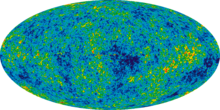- de Sitter universe
-
Physical cosmology 
Universe · Big Bang
Age of the universe
Timeline of the Big Bang
Ultimate fate of the universeEarly universeExpanding universeComponentsA de Sitter universe is a cosmological solution to Einstein's field equations of General Relativity which is named after Willem de Sitter. It models the universe as spatially flat and neglects ordinary matter, so the dynamics of the universe are dominated by the cosmological constant, thought to correspond to dark energy in our universe or the inflaton field in the early universe. According to the models of inflation and current observations of the accelerating universe, the concordance models of physical cosmology are converging on a consistent model where our universe was best described as a de Sitter universe at about a time t = 10 − 33 seconds after the fiducial Big Bang singularity, and far into the future.
Contents
Mathematical Expression
A de Sitter universe has no ordinary matter content but with a positive cosmological constant which sets the expansion rate, H. A larger cosmological constant leads to a larger expansion rate:
 ,
,where the constants of proportionality depend on conventions. The cosmological constant is Λ.
It is common to describe a patch of this solution as an expanding universe of the FLRW form where the scale factor is given by[1]
a(t) = eHt, where the constant H is the Hubble expansion rate and t is time. As in all FLRW spaces, a(t), the scale factor, describes the expansion of physical spatial distances.
Unique to universes described by the FLRW metric, a de Sitter universe has a Hubble Law which is not only consistent through all space, but also through all time (since the deceleration parameter is equal to q = − 1), thus satisfying the perfect cosmological principle that assumes isotropy and homogeneity throughout space and time. As a class of models with different values of the Hubble constant, the static universe that Einstein developed, and for which he invented the cosmological constant, can be considered a special case of the de Sitter universe where the expansion is finely tuned to just cancel out the collapse associated with the positive curvature associated with a non-zero matter density. There are ways to cast de Sitter space with static coordinates (see de Sitter space), so unlike other FLRW models, de Sitter space can be thought of as a static solution to Einstein's equations even though the geodesics followed by observers necessarily diverge in the normal way expected from the expansion of physical spatial dimensions. As a model for the universe, de Sitter's solution was not considered viable for the observed universe until models for inflation and dark energy were developed. Before then, it was assumed that the Big Bang implied only an acceptance of the weaker cosmological principle which holds isotropy true only for spatial extents but not temporal extents.[2]
Potential for Universe
Because our Universe entered the Dark Energy Dominated Era a few billion years ago, our universe is probably approaching a de Sitter universe in the infinite future. If the current acceleration of our universe is due to a cosmological constant then as the universe continues to expand all of the matter and radiation will be diluted. Eventually there will be almost nothing left but the cosmological constant, and our universe will have become a de Sitter universe.
Relative Expansion
The exponential expansion of the scale factor means that the physical distance between any two non-accelerating observers will eventually be growing faster than the speed of light. At this point those two observers will no longer be able to make contact. Therefore any observer in a de Sitter universe would see event horizons beyond which that observer can never see nor learn any information. If our universe is approaching a de Sitter universe then eventually we will not be able to observe any galaxies other than our own Milky Way (and any others in the gravitationally bound Local Group, assuming they were to somehow survive to that time without merging).
Modelling cosmic inflation
Another application of de Sitter space is in the early universe during cosmic inflation. Many inflationary models are approximately de Sitter space and can be modelled by giving the Hubble parameter a mild time dependence. For simplicity, some calculations involving inflation in the early universe can be performed in de Sitter space rather than a more realistic inflationary universe. By using the de Sitter universe instead, where the expansion is truly exponential, there are many simplifications.
See also
- Cosmic inflation
- De Sitter space for more mathematical properties
- Deceleration parameter
- Causal patch
References
- ^ R. Adler, M. Bazin, M. Schiffer. Introduction to General Relativity, McGraw-Hill 1965. ASIN B0017ODHG2
- ^ S. Dodelson. Modern Cosmology, Academic Press, 2003. ISBN 978-0122191411
Wikimedia Foundation. 2010.
